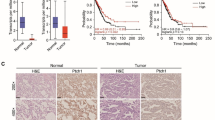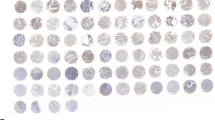Abstract
Cancer metastasis is considered a major challenge in cancer therapy. Recently, epidermal growth factor (EGF)/epidermal growth factor receptor (EGFR) signaling has been shown to induce epithelial-mesenchymal transition (EMT) and thereby to promote cancer metastasis. However, the underlying mechanism has not been fully elucidated. We demonstrate that EGF can induce EMT in human prostate and lung cancer cells and thus promote invasion and migration. EGF-induced EMT has been characterized by the cells acquiring mesenchymal spindle-like morphology and increasing their expression of N-cadherin and fibronectin, with a concomitant decrease of E-cadherin. Both protein and mRNA expression of transcription factor Snail rapidly increases after EGF treatment. The knockdown of Snail significantly attenuates EGF-induced EMT, suggesting that Snail is crucial for this process. To determine the way that Snail is accumulated, we demonstrate (1) that EGF promotes the stability of Snail via inhibiting the activity of glycogen synthase kinase 3 beta (GSK-3β), (2) that protein kinase C (PKC) rather than the phosphatidylinositide 3-kinase (PI3K)/protein kinase B (AKT) signaling pathway is responsible for GSK-3β inhibition and (3) that GSK-3β inhibition promotes the transcription of Snail. Taken together, these results reveal that the PKC/GSK-3β signaling pathway controls both the stability and transcription of Snail, which is crucial for EMT induced by EGF in PC-3 and A549 cells. Our study suggests a novel signaling pathway for Snail regulation and provides a better understanding of growth-factor-induced tumor EMT and metastasis.








Similar content being viewed by others
References
Ackland ML, Newgreen DF, Fridman M, Waltham MC, Arvanitis A, Minichiello J, Price JT, Thompson EW (2003) Epidermal growth factor-induced epithelio-mesenchymal transition in human breast carcinoma cells. Lab Invest 83:435–448
Argast G, Krueger J, Thomson S, Sujka-Kwok I, Carey K, Silva S, O’Connor M, Mercado P, Mulford I, Young GD, Sennello R, Wild R, Pachter J, Kan JC, Haley J, Rosenfeld-Franklin M, Epstein D (2011) Inducible expression of TGFβ, snail and Zeb1 recapitulates EMT in vitro and in vivo in a NSCLC model. Clin Exp Metastasis 28:593–614
Bachelder RE, Yoon S-O, Franci C, de Herreros AG, Mercurio AM (2005) Glycogen synthase kinase-3 is an endogenous inhibitor of snail transcription: implications for the epithelial–mesenchymal transition. J Cell Biol 168:29–33
Barbera MJ, Puig I, Dominguez D, Julien-Grille S, Guaita-Esteruelas S, Peiro S, Baulida J, Franci C, Dedhar S, Larue L, Garcia de Herreros A (2004) Regulation of Snail transcription during epithelial to mesenchymal transition of tumor cells. Oncogene 23:7345–7354
Chen KC, Chen CY, Lin CJ, Yang TY, Chen TH, Wu LC, Wu CC (2013) Luteolin attenuates TGF-β1-induced epithelial–mesenchymal transition of lung cancer cells by interfering in the PI3K/Akt–NF-κB–snail pathway. Life Sci 93:924–933
Christofori G (2006) New signals from the invasive front. Nature 441:444–450
Connor P, Talavera F, Kang J-S, Burke J, Roberts J, Menon KMJ (1997) Epidermal growth factor activates protein kinase C in the human endometrial cancer cell line HEC-1-a. Gynecol Oncol 67:46–50
Cross DAE, Alessi DR, Cohen P, Andjelkovich M, Hemmings BA (1995) Inhibition of glycogen synthase kinase-3 by insulin mediated by protein kinase B. Nature 378:785–789
De Craene B, van Roy F, Berx G (2005) Unraveling signalling cascades for the Snail family of transcription factors. Cell Signal 17:535–547
Doble BW, Woodgett JR (2003) GSK-3: tricks of the trade for a multi-tasking kinase. J Cell Sci 116:1175–1186
Dong C, Wu Y, Yao J, Wang Y, Yu Y, Rychahou PG, Evers BM, Zhou BP (2012) G9a interacts with snail and is critical for snail-mediated E-cadherin repression in human breast cancer. J Clin Invest 122:1469–1486
Fang R, Zhang G, Guo Q, Ning F, Wang H, Cai S, Du J (2013) Nodal promotes aggressive phenotype via snail-mediated epithelial–mesenchymal transition in murine melanoma. Cancer Lett 333:66–75
Fang X, Yu SX, Lu Y, Bast RC, Woodgett JR, Mills GB (2000) Phosphorylation and inactivation of glycogen synthase kinase 3 by protein kinase A. Proc Natl Acad Sci 97:11960–11965
Goode N, Hughes K, Woodgett JR, Parker PJ (1992) Differential regulation of glycogen synthase kinase-3 beta by protein kinase C isotypes. J Biol Chem 267:16878–16882
Goswami S, Sahai E, Wyckoff JB, Cammer M, Cox D, Pixley FJ, Stanley ER, Segall JE, Condeelis JS (2005) Macrophages promote the invasion of breast carcinoma cells via a colony-stimulating factor-1/epidermal growth factor paracrine loop. Cancer Res 65:5278–5283. doi:10.1158/0008-5472.can-04-1853
Gould CM, Newton AC (2008) The life and death of protein kinase C. Curr Drug Targets 9:614–625
Ha GH, Kim JL, Breuer EK (2013) TACC3 is essential for EGF-mediated EMT in cervical cancer. PLoS One 8:e70353
Hanahan D, Weinberg RA (2011) Hallmarks of cancer: the next generation. Cell 144:646–674
Hung JJ, Yang MH, Hsu HS, Hsu WH, Liu JS, Wu KJ (2009) Prognostic significance of hypoxia-inducible factor-1α, TWIST1 and Snail expression in resectable non-small cell lung cancer. Thorax 64:1082–1089
Lee MY, Lee SH, Kim YH, Heo JS, Park SH, Lee JH, Han HJ (2006) Effect of EGF on [3H]-thymidine incorporation and cell cycle regulatory proteins in primary cultured chicken hepatocytes: involvement of Ca2+/PKC and MAPKs. J Cell Biochem 99:1677–1687
Lee MY, Chou CY, Tang MJ, Shen MR (2008) Epithelial-mesenchymal transition in cervical cancer: correlation with tumor progression, epidermal growth factor receptor overexpression, and snail up-regulation. Clin Cancer Res 14:4743–4750
Lo H-W, Hsu S-C, Xia W, Cao X, Shih J-Y, Wei Y, Abbruzzese JL, Hortobagyi GN, Hung M-C (2007) Epidermal growth factor receptor cooperates with signal transducer and activator of transcription 3 to induce epithelial-mesenchymal transition in cancer cells via up-regulation of TWIST gene expression. Cancer Res 67:9066–9076
Logullo AF, Nonogaki S, Pasini FS, Osório CA, Soares FA, Brentani MM (2010) Concomitant expression of epithelial-mesenchymal transition biomarkers in breast ductal carcinoma: association with progression. Oncol Rep 23:313–320
Lu X, Kang Y (2009) Epidermal growth factor signalling and bone metastasis. Br J Cancer 102:457–461
Mak P, Leav I, Pursell B, Bae D, Yang X, Taglienti CA, Gouvin LM, Sharma VM, Mercurio AM (2010) ERβ impedes prostate cancer EMT by destabilizing HIF-1α and inhibiting VEGF-mediated snail nuclear localization: implications for Gleason grading. Cancer Cell 17:319–332
Mendelsohn J, Baselga J (2000) The EGF receptor family as targets for cancer therapy. Oncogene 19:6550–6556
Nieto MA (2002) The snail superfamily of zinc-finger transcription factors. Nat Rev Mol Cell Biol 3:155–166
Olmeda D, Jorda M, Peinado H, Fabra A, Cano A (2006) Snail silencing effectively suppresses tumour growth and invasiveness. Oncogene 26:1862–1874
Peinado H, Olmeda D, Cano A (2007) Snail, Zeb and bHLH factors in tumour progression: an alliance against the epithelial phenotype? Nat Rev Cancer 7:415–428
Pon YL, Zhou HY, Cheung ANY, Ngan HYS, Wong AST (2008) p70 S6 kinase promotes epithelial to mesenchymal transition through snail induction in ovarian cancer cells. Cancer Res 68:6524–6532
Saito Y, Vandenheede JR, Cohen P (1994) The mechanism by which epidermal growth factor inhibits glycogen synthase kinase 3 in A431 cells. Biochem J 303:27–31
Salomon DS, Brandt R, Ciardiello F, Normanno N (1995) Epidermal growth factor-related peptides and their receptors in human malignancies. Crit Rev Oncol Hematol 19:183–232
Schreiber E, Harshman K, Kemler I, Malipiero U, Schaffner W, Fontana A (1990) Astrocytes and glioblastoma cells express novel octamer-DNA binding proteins distinct from the ubiquitous Oct-1 and B cell type Oct-2 proteins. Nucleic Acids Res 18:5495–5503
Shinojima N, Tada K, Shiraishi S, Kamiryo T, Kochi M, Nakamura H, Makino K, Saya H, Hirano H, Kuratsu J, Oka K, Ishimaru Y, Ushio Y (2003) Prognostic value of epidermal growth factor receptor in patients with glioblastoma multiforme. Cancer Res 63:6962–6970
Smith BN, Odero-Marah VA (2012) The role of snail in prostate cancer. Cell Adhes Migr 6:433–441
Stewart JR, O’Brian CA (2005) Protein kinase C-α mediates epidermal growth factor receptor transactivation in human prostate cancer cells. Mol Cancer Ther 4:726–732
Tomaskovic-Crook E, Thompson E, Thiery J (2009) Epithelial to mesenchymal transition and breast cancer. Breast Cancer Res 11:213
Tortora G, Damiano V, Bianco C, Baldassarre G, Bianco AR, Lanfrancone L, Pelicci PG, Ciardiello F (1997) The RIalpha subunit of protein kinase A (PKA) binds to Grb2 and allows PKA interaction with the activated EGF-receptor. Oncogene 14:923–928
Vergara D, Valente CM, Tinelli A, Siciliano C, Lorusso V, Acierno R, Giovinazzo G, Santino A, Storelli C, Maffia M (2011) Resveratrol inhibits the epidermal growth factor-induced epithelial mesenchymal transition in MCF-7 cells. Cancer Lett 310:1–8
Wang H, Wang H-S, Zhou B-H, Li C-L, Zhang F, Wang X-F, Zhang G, Bu X-Z, Cai S-H, Du J (2013) Epithelial–mesenchymal transition (EMT) induced by TNF-α requires AKT/GSK-3β-mediated stabilization of snail in colorectal cancer. PLoS One 8:e56664
Wang Y, Lin Z, Sun L, Fan S, Huang Z, Zhang D, Yang Z, Li J, Chen W (2013a) Akt/Ezrin Tyr353/NF-κB pathway regulates EGF-induced EMT and metastasis in tongue squamous cell carcinoma. Br J Cancer 110:695–705
Wang Y, Shi J, Chai K, Ying X, Zhou BP (2013b) The role of snail in EMT and tumorigenesis. Curr Cancer Drug Targets 13:963–972
Wen YC, Chen WY, Lee WJ, Yang SF, Lee LM, Chien MH (2014) Snail as a potential marker for predicting the recurrence of prostate cancer in patients at stage T2 after radical prostatectomy. Clin Chim Acta 431:169–173
Wu Y, Zhou BP (2010) Snail: more than EMT. Cell Adhes Migr 4:199–203
Wu Y, Deng J, Rychahou PG, Qiu S, Evers BM, Zhou BP (2009) Stabilization of snail by NF-kB is required for inflammation-induced cell migration and invasion. Cancer Cell 15:416–428
Wyckoff JB, Wang Y, Lin EY, Li JF, Goswami S, Stanley ER, Segall JE, Pollard JW, Condeelis J (2007) Direct visualization of macrophage-assisted tumor cell intravasation in mammary tumors. Cancer Res 67:2649–2656
Xue C, Plieth D, Venkov C, Xu C, Neilson EG (2003) The gatekeeper effect of epithelial-mesenchymal transition regulates the frequency of breast cancer metastasis. Cancer Res 63:3386–3394
Yarden Y (2001) The EGFR family and its ligands in human cancer: signalling mechanisms and therapeutic opportunities. Eur J Cancer 37 Suppl 4:S3–S8
Zeisberg M, Neilson EG (2009) Biomarkers for epithelial-mesenchymal transitions. J Clin Invest 119:1429–1437
Zhou BP, Deng J, Xia W, Xu J, Li YM, Gunduz M, Hung M-C (2004) Dual regulation of snail by GSK-3 [beta]-mediated phosphorylation in control of epithelial-mesenchymal transition. Nat Cell Biol 6:931–940
Zuo JH, Zhu W, Li MY, Li XH, Yi H, Zeng GQ, Wan XX, He QY, Li JH, Qu JQ, Chen Y, Xiao ZQ (2011) Activation of EGFR promotes squamous carcinoma SCC10A cell migration and invasion via inducing EMT-like phenotype change and MMP-9-mediated degradation of E-cadherin. J Cell Biochem 112:2508–2517
Acknowledgments
This study was supported by grants from the National Program on Key Basic Research Project (973 Program) (no. 2011CB935800) and the National Natural Science Foundation of China (nos. 81272311 and 81071712).
Competing interests
The authors declare that they have no competing interests.
Author information
Authors and Affiliations
Corresponding authors
Rights and permissions
About this article
Cite this article
Liu, Zc., Chen, Xh., Song, Hx. et al. Snail regulated by PKC/GSK-3β pathway is crucial for EGF-induced epithelial-mesenchymal transition (EMT) of cancer cells. Cell Tissue Res 358, 491–502 (2014). https://doi.org/10.1007/s00441-014-1953-2
Received:
Accepted:
Published:
Issue Date:
DOI: https://doi.org/10.1007/s00441-014-1953-2




